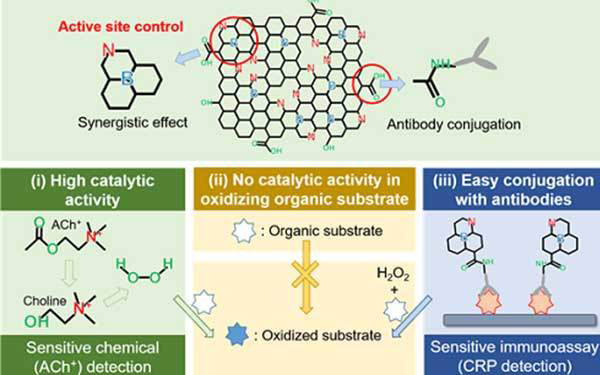Nanozymes: The Next Generation of Enzyme Mimetics
What are Nanozymes?
Nanozymes are nanomaterials that exhibit enzyme-like catalytic properties. They are designed to mimic the structure and function of natural enzymes, offering unique advantages such as high stability, low cost, and ease of modification. Nanozymes have emerged as a promising alternative to traditional enzymes in various applications, including biosensing, environmental remediation, and therapeutic interventions.

Types of Nanozymes
Several types of nanomaterials have been explored as nanozymes, each with unique properties and catalytic activities:
- Metal Nanoparticles: Gold, silver, and platinum nanoparticles have been widely studied as nanozymes due to their excellent catalytic properties and ease of synthesis. These metal nanoparticles exhibit peroxidase, oxidase, and superoxide dismutase-like activities.
- Metal Oxide Nanoparticles: Iron oxide, cerium oxide, and titanium dioxide nanoparticles have shown remarkable enzyme-mimicking capabilities. They possess peroxidase, catalase, and superoxide dismutase-like activities, making them suitable for various biomedical and environmental applications.
- Carbon-Based Nanomaterials: Graphene, carbon nanotubes, and carbon dots have emerged as promising nanozymes. They exhibit peroxidase, oxidase, and catalase-like activities, and their unique electronic properties make them attractive for biosensing and bioimaging applications.
Advantages of Nanozymes
Nanozymes offer several advantages over natural enzymes:
- High Stability: Nanozymes are highly stable under extreme conditions, such as high temperatures, wide pH ranges, and the presence of denaturants. This stability makes them suitable for applications in harsh environments where natural enzymes may lose their activity.
- Cost-Effectiveness: The synthesis of nanozymes is generally more cost-effective compared to the production of natural enzymes. Nanozymes can be produced in large quantities using simple and scalable methods, making them economically viable for industrial applications.
- Tunability: The catalytic properties of nanozymes can be easily tuned by modifying their size, shape, composition, and surface functionalization. This tunability allows for the optimization of nanozymes for specific applications and enhances their catalytic efficiency.
- Multifunctionality: Nanozymes can be designed to possess multiple catalytic activities, mimicking the function of different enzymes simultaneously. This multifunctionality enables the development of integrated systems for complex chemical transformations and biosensing applications.
Applications of Nanozymes
Nanozymes have found applications in various fields, leveraging their unique catalytic properties:
Biosensing and Diagnostics
Nanozymes have been extensively explored for the development of sensitive and selective biosensors. By replacing natural enzymes with nanozymes in biosensing platforms, researchers have achieved improved stability, sensitivity, and cost-effectiveness. Nanozyme-based biosensors have been developed for the detection of glucose, hydrogen peroxide, cancer biomarkers, and infectious agents.
Environmental Remediation
Nanozymes have shown great potential in environmental remediation applications, particularly in the degradation of pollutants and the treatment of wastewater. Metal oxide nanozymes, such as iron oxide and cerium oxide nanoparticles, have been used to catalyze the decomposition of organic pollutants and the reduction of toxic metal ions in contaminated water.
Therapeutics and Drug Delivery
Nanozymes have been explored as therapeutic agents for various diseases, including cancer, inflammation, and neurodegenerative disorders. By leveraging their catalytic activities, nanozymes can generate reactive oxygen species (ROS) to induce cell death in cancer cells or scavenge ROS to alleviate oxidative stress in inflammatory conditions. Additionally, nanozymes can be used as drug delivery vehicles, enabling targeted and controlled release of therapeutic agents.
Challenges and Future Perspectives
Despite the significant progress in nanozyme research, several challenges need to be addressed for their widespread application. One of the main challenges is the limited understanding of the structure-activity relationships of nanozymes, which hinders the rational design of nanozymes with desired catalytic properties. Additionally, the long-term stability and potential toxicity of nanozymes in biological systems need to be thoroughly investigated.
Future research in nanozyme development will focus on the design of multi-functional nanozymes with enhanced catalytic efficiency and specificity. The integration of nanozymes with other nanomaterials, such as responsive polymers and biomolecules, will enable the creation of smart and adaptive nanozyme systems for advanced applications. Furthermore, the exploration of nanozymes for in vivo applications, such as targeted drug delivery and enzyme replacement therapy, will be a key area of investigation.
Further Reading
Journal of Nanobiotechnology, Nanozymes – recent development and biomedical applications
Nano-Micro Letters, A Review on Metal- and Metal Oxide-Based Nanozymes: Properties, Mechanisms, and Applications
Advanced Materials, Nanozymes: Definition, Activity, and Mechanisms
